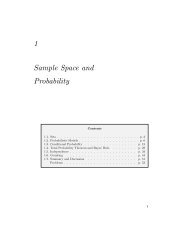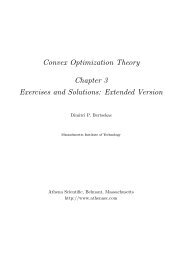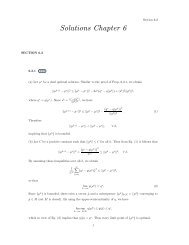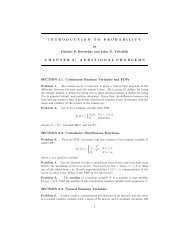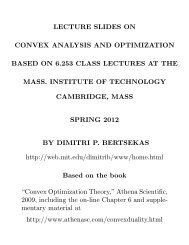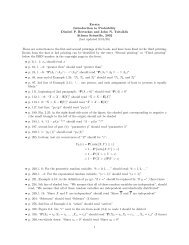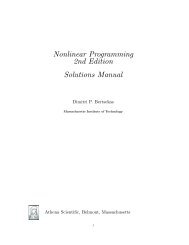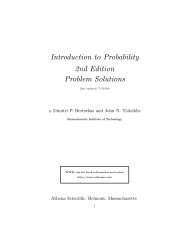Introduction to Probability, by Dimitri P ... - satrajit mukherjee
Introduction to Probability, by Dimitri P ... - satrajit mukherjee
Introduction to Probability, by Dimitri P ... - satrajit mukherjee
You also want an ePaper? Increase the reach of your titles
YUMPU automatically turns print PDFs into web optimized ePapers that Google loves.
14 Sample Space and <strong>Probability</strong> Chap. 1<br />
Properties of <strong>Probability</strong> Laws<br />
<strong>Probability</strong> laws have a number of properties, which can be deduced from the<br />
axioms. Some of them are summarized below.<br />
Some Properties of <strong>Probability</strong> Laws<br />
Consider a probability law, and let A, B, and C be events.<br />
(a) If A ⊂ B, then P(A) ≤ P(B).<br />
(b) P(A ∪ B) =P(A)+P(B) − P(A ∩ B).<br />
(c) P(A ∪ B) ≤ P(A)+P(B).<br />
(d) P(A ∪ B ∪ C) =P(A)+P(A c ∩ B)+P(A c ∩ B c ∩ C).<br />
These properties, and other similar ones, can be visualized and verified<br />
graphically using Venn diagrams, as in Fig. 1.6. Note that property (c) can be<br />
generalized as follows:<br />
P(A 1 ∪ A 2 ∪···∪A n ) ≤<br />
n∑<br />
P(A i ).<br />
To see this, we apply property (c) <strong>to</strong> the sets A 1 and A 2 ∪···∪A n ,<strong>to</strong>obtain<br />
i=1<br />
P(A 1 ∪ A 2 ∪···∪A n ) ≤ P(A 1 )+P(A 2 ∪···∪A n ).<br />
We also apply property (c) <strong>to</strong> the sets A 2 and A 3 ∪···∪A n ,<strong>to</strong>obtain<br />
P(A 2 ∪···∪A n ) ≤ P(A 2 )+P(A 3 ∪ ···∪A n ).<br />
We continue similarly, and finally add.<br />
Models and Reality<br />
The framework of probability theory can be used <strong>to</strong> analyze uncertainty in a<br />
wide variety of physical contexts. Typically, this involves two distinct stages.<br />
(a) In the first stage, we construct a probabilistic model, <strong>by</strong> specifying a probability<br />
law on a suitably defined sample space. There are no hard rules <strong>to</strong><br />
guide this step, other than the requirement that the probability law conform<br />
<strong>to</strong> the three axioms. Reasonable people may disagree on which model<br />
best represents reality. In many cases, one may even want <strong>to</strong> use a somewhat<br />
“incorrect” model, if it is simpler than the “correct” one or allows for<br />
tractable calculations. This is consistent with common practice in science



